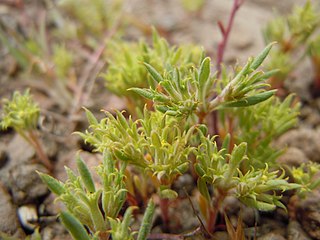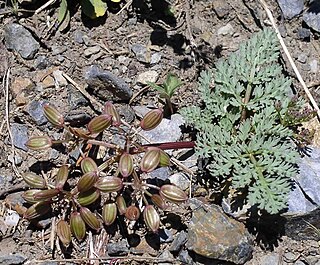
The Polemoniaceae are a family of flowering plants consisting of about 25 genera with 270–400 species of annuals and perennials native to the Northern Hemisphere and South America, with the center of diversity in western North America.
Amaranthus watsonii is a species of amaranth known by the common name Watson's amaranth. It is native to the southwestern United States and northern Mexico, where it grows in sandy places such as deserts and beaches, and disturbed areas. It is also known as a rare introduced species in parts of Europe. This is an erect annual herb producing a glandular hairy stem to a maximum height of about a meter. The leaves are generally oval-shaped and up to 8 centimeters long, with a petiole of up to 9 centimeters. The species is dioecious, with male and female individuals producing different types of flowers. The inflorescence is a long spike cluster of flowers interspersed with spiny green glandular bracts. The fruit is a smooth capsule about 2 millimeters long that snaps in half to reveal a small shiny reddish black seed.

Atriplex watsonii is a species of saltbush known by the common name Watson's saltbush, or Watson's orach. It is native to the coastline of California and Baja California, where it grows in coastal areas with saline soils, such as salt marshes and beach scrub, with other halophytes such as saltgrass. It extends inland in the Los Angeles Basin, and along the Santa Ana River.

Chorizanthe watsonii is a species of flowering plant in the buckwheat family known by the common name Fivetooth Spineflower or Watson's Spineflower. They are an annual herb native to the western United States including Idaho, California, Oregon, Nevada, Utah, Washington and Arizona, namely the Mojave Desert which runs through many of them.
Hackelia brevicula is a species of flowering plant in the borage family known by the common name Poison Canyon stickseed.
Phlox dolichantha is a species of phlox known by the common name Big Bear Valley phlox. It is endemic to San Bernardino County, California, where it is limited to the area around Big Bear Lake in the San Bernardino Mountains. It grows in forests and the unique local pebble plain habitat. It occurs at elevations over 2000 meters. It is an erect, branching perennial herb growing up to 30 centimeters tall. The linear or narrowly lance-shaped leaves are 2 to 5 centimeters long and are oppositely arranged on the slender stems. The inflorescence is made up of one or more showy flowers at the tip of the stem. Each flower has a very slender tubular throat up to 5 centimeters long which can be white, pink, or lavender.
Selaginella watsonii is a species of spikemoss known by the common name Watson's spikemoss. It is native to the western United States, where it grows in many rocky habitat types, including high mountain peaks in alpine climates. This lycophyte forms mats or cushions of short, forking stems. They are lined with linear or lance-shaped leaves no more than 4 millimeters long, often tipped with tiny bristles. The strobili containing the reproductive structures are 1 to 3 centimeters long.

Tricardia is a monotypic genus of flowering plants in the borage family containing the single species Tricardia watsonii, which is known by the common name threehearts. It is native to the southwestern United States, where it grows in deserts and mountains in sandy open habitat, often beneath shrubs. It is a perennial herb growing from a taproot and a woody caudex covered with the shreddy remains of previous seasons' herbage. It produces several erect stems up to about 40 centimeters tall. Most of the leaves are located in a basal rosette about the caudex. They are lance-shaped and coated thinly in woolly hairs. They are up to 9 centimeters long and are borne on petioles. A few smaller leaves occur higher on the stem. Flowers occur in a loose cyme at the top of the stem. Each has a calyx of five sepals. The outer three are heart-shaped and green to pink or purple in color, and the inner two are much smaller and narrower. The flower within is bell-shaped, white with central purple markings, and roughly half a centimeter wide. The fruit is a capsule just under a centimeter long which contains 4 to 8 seeds.
Gilia yorkii is a rare species of flowering plant in the phlox family known by the common names Boyden Cave gilia and monarch gilia. It is endemic to Fresno County, California, where it is known from only one location in the southern Sierra Nevada. This plant grows in rock cracks in the limestone cliffs and outcrops in the chaparral and woodlands of the canyon.

Ipomopsis sancti-spiritus is a rare species of flowering plant in the phlox family known by the common name Holy Ghost ipomopsis. It is endemic to New Mexico in the United States, where it is known from only one canyon in the Sangre de Cristo Mountains. It is a federally listed endangered species.

Schoenocrambe argillacea is a rare species of flowering plant in the mustard family known by the common names clay reed-mustard, Uinta Basin plainsmustard, and clay thelypody.

Lomatium erythrocarpum, known by the common name redfruit desertparsley, is a rare species of flowering plant in the carrot family. It is endemic to Oregon in the United States, where it is limited to a section of the Blue Mountains within Baker County.
Cymopterus goodrichii is a rare species of flowering plant in the carrot family known by the common name Toiyabe springparsley. It is endemic to Nevada in the United States, where it occurs in the Toiyabe and West Humboldt Ranges.
Primula capillaris is a rare species of flowering plant in the primrose family known by the common name Ruby Mountains primrose, or Ruby Mountain primrose. It is endemic to Nevada in the United States, where it is limited to the Ruby Mountains of Elko County.
Viola frank-smithii is a rare species of violet known by the common name Frank Smith's violet. It is endemic to Utah in the United States, where it is known only from Logan Canyon in the Bear River Range in Cache County.
Astragalus leptaleus is a species of flowering plant in the legume family known by the common name park milkvetch. It is native to the Rocky Mountains of the United States, where it occurs in Idaho, Montana, Wyoming, and Colorado.
Aliciella penstemonoides is a species of flowering plant in the phlox family known by the common names Black Canyon gilia and beardtongue gilia. It is endemic to Colorado in the United States.
Argemone pinnatisecta, known as the Sacramento prickly poppy, is an angiosperm and part of the poppy family. A very thorny looking perennial that grows up to a meter and a half in height. The thorny stems are covered in bluish green serrated leaves with spiky tips. The flower buds are also covered in these sharp thin thorns until they open, between May and August, revealing six white petals up to four centimeters long and nine centimeters wide, and a bright yellow anther with various stamens jetting out. The fruits of plant contain black seeds about two millimeters in diameter.
Erigeron watsonii is a rare North American species of flowering plant in the family Asteraceae known by the common name Watson's fleabane. It in the mountainous areas of the western United States, in the states of Idaho, Nevada, and Utah.








